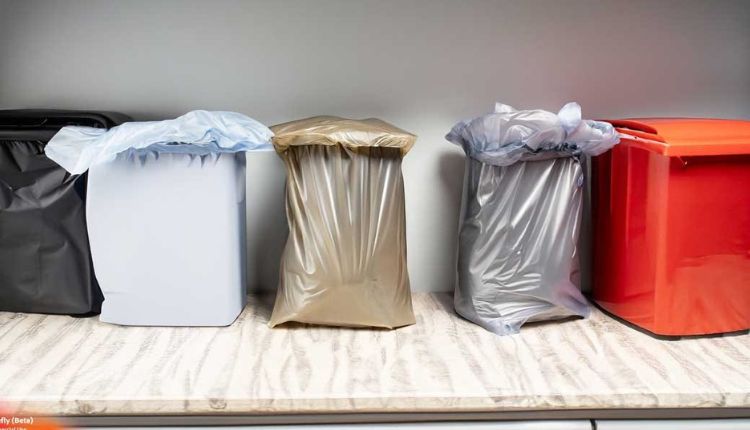Choosing the right trash bag for your kitchen may seem simple, but the thickness of the bag plays a crucial role in how well it performs. Trash bag thickness determines its strength, resistance to punctures or tears, and how much weight it can hold. If you’ve ever had a garbage bag rip or leak, you know how frustrating and messy it can be. The good news is that by selecting the right thickness, you can avoid those unpleasant situations.
In this guide, we’ll explore how thick your kitchen trash bag should be, with a focus on why a 0.9 mil thickness is ideal for most households. We’ll also cover other important factors like the size and type of material that will help you choose the perfect trash bag.
Why Thickness Matters
The thickness of a trash bag directly affects its durability. Thin bags are more prone to tearing, especially when dealing with sharp or heavy waste like food scraps, broken glass, or cans. Thicker bags, on the other hand, are more robust and designed to withstand rougher materials without tearing or leaking.
In a kitchen environment, where you’re often throwing away a mix of wet food waste, packaging, and sometimes sharp objects, it’s important to choose a bag that offers the right balance between strength and flexibility. If your bag is too thin, it might tear when you’re carrying it out, leading to spills and odors.
Understanding Trash Bag Thickness
Trash bag thickness is measured in mils, with 1 mil equaling one-thousandth of an inch (0.001 inches). The higher the mil number, the thicker and stronger the bag.
Here’s a breakdown of common thickness levels:
- 5 – 0.7 mil: Thin and lightweight, suitable for very light materials like paper towels and tissues. These are not recommended for kitchen use.
- 8 – 0.9 mil: Standard for kitchen trash bags. These provide adequate strength for regular household waste while remaining flexible and cost-effective.
- 0 – 1.2 mil: A bit stronger, these are good for households that generate heavier waste or want added protection against tears.
- 5 – 2.0 mil: Heavy-duty bags, ideal for extremely heavy or sharp waste but may be overkill for typical kitchen trash.
For most kitchen use, a 0.9 mil thickness is sufficient. It strikes a great balance between being durable enough to prevent leaks and tears, while still being cost-effective and not too thick or bulky.
Size Considerations: Garbage Bags 13 Gallon
While thickness is essential, it’s also crucial to choose the right size trash bag. For most kitchen bins, garbage bags 13 gallon in size are standard. These bags are designed to fit most kitchen trash cans perfectly, allowing for enough capacity without overflowing or wasting material.
If you use a smaller or larger bag than your trash can size, it can lead to problems like spills or difficulty securing the bag. Sticking to the proper size ensures your kitchen stays clean and the bag remains easy to handle when full.
For a standard kitchen trash can, garbage bags 13 gallon are ideal, especially when combined with a 0.9 mil thickness for regular waste disposal.
Assessing Your Waste
Your household waste patterns also play a significant role in determining the thickness of your trash bag. If your kitchen waste primarily consists of light materials like paper towels, food packaging, and non-sharp objects, a 0.9 mil bag will perform just fine.
However, if you frequently dispose of messier or heavier waste such as food scraps, liquid-heavy materials, or broken containers, a slightly thicker bag (like 1.0 – 1.2 mil) might offer more peace of mind.
Still, for the majority of households, a 0.9 mil bag offers the right balance of durability and flexibility, handling most types of waste efficiently without unnecessary thickness.
Materials Used in Trash Bags
The material a trash bag is made from also influences its strength. Most trash bags are made from either low-density polyethylene (LDPE) or high-density polyethylene (HDPE).
- Low-Density Polyethylene (LDPE): This material is more flexible and resistant to tearing, making it perfect for handling rough or heavy waste.
- High-Density Polyethylene (HDPE): These bags are thinner but more rigid and can be prone to puncturing. HDPE is better for light, dry waste.
For kitchen trash bags, LDPE is generally preferred, as it provides the right amount of stretch and durability to prevent leaks and tears, especially at a 0.9 mil thickness.
How to Choose the Right Trash Bag for Your Kitchen
1. Consider Your Waste Type
Think about the kind of waste your household generates. If you mostly throw away light, non-sharp items, a 0.9 mil trash bag will suit your needs perfectly. If you regularly dispose of heavy or sharp waste, consider a slightly thicker bag to prevent leaks.
2. Pick the Right Size
Ensure the bag size matches your trash can. Most kitchens use garbage bags 13 gallon in size, which fits standard kitchen trash cans. These bags, combined with a 0.9 mil thickness, will be sufficient for everyday use in most households.
3. Look for Additional Features
Some trash bags come with extra features such as odor control, drawstrings, or reinforced bottoms. These features can be helpful for busy kitchens where strong odors or leaks are a concern. If you find yourself frequently dealing with food waste, opting for bags that offer odor protection can make a noticeable difference.
4. Buy in Bulk
If you find a trash bag that meets your needs, consider buying in bulk. This is a great way to save money and ensure you always have a supply of bags that fit your kitchen trash can perfectly.
Why 0.9 Mil Is Ideal for Kitchen Trash Bags
When it comes to balancing performance and cost, a 0.9 mil trash bag hits the sweet spot. Here’s why:
- Sufficient Strength: At 9 mil, the bag can handle typical kitchen waste, from food scraps to light packaging, without tearing easily.
- Flexibility: It offers enough flexibility to avoid punctures when disposing of items with sharp edges, such as bones or plastic containers.
- Cost-Effective: Thicker bags like 5 mil or more are often overkill for kitchen use, leading to unnecessary expense. A 0.9 mil bag provides just the right amount of durability at a lower cost.
- Versatility: These bags are great for a variety of uses beyond the kitchen, including bathroom, office, and light outdoor trash needs.
Conclusion
Choosing the right thickness for your kitchen trash bags is essential for keeping your kitchen clean and hassle-free. For most households, a 0.9 mil thickness provides the perfect balance of strength, flexibility, and cost-effectiveness. This thickness is durable enough to prevent leaks and tears, making it suitable for everyday kitchen waste.
When combined with the proper size—such as garbage bags 13 gallon—and additional features like odor control, 0.9 mil trash bags tall kitchen are an excellent option for regular use in any household. By selecting the right thickness and size, you can ensure that taking out the trash is a simple and mess-free task.






